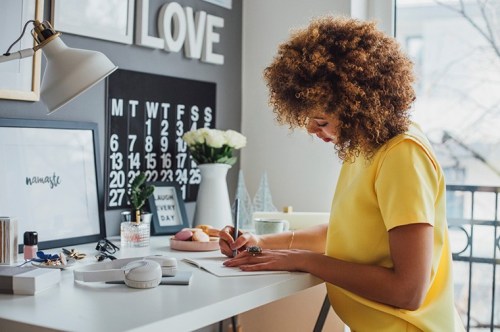Taking a 15-minute walk on your lunch break or sneaking into an empty conference room for a short meditation would probably make your day a little less stressful. But when your emails are piling up and you have a deadline looming, the likelihood of that happening is about as probable as Whole Foods handing out free avocados.
Fortunately, according to creativity and mindfulness coach Rebecca Kronman, there are ways to work some mindful practices into your day without taking any time away from what’s already on your to-do list. Kronman has a background in social work and is also trained in mindfulness and stress reduction. She’s taught yoga, meditation, creativity, and mindfulness tips to everyone from prisoners to high level execs—vastly different groups of people, yet all very susceptible to stress. Something she’s heard repeatedly from execs is that mindfulness sounds great in theory, but there just isn’t time to do it.
Have no fear, busy workers. Her tips are designed to be worked into your day, not added to it.
Keep reading to find out how to master the art of being mindful at work.

Pay attention to your breath
“A lot of people spend a good portion of the day not breathing very deeply,” Kronman says. She explains that when you start to feel stressed—like when you get an email from the CEO or you’re waiting for a text from your S.O. about something going on at home—often, your breath becomes more shallow without you even realizing it. And not taking full, deep breaths inadvertently stresses out the body.
“What’s happening in the body is a fight, flight, or freeze response kicking in,” Kronman explains. “Not breathing [deeply] is almost like you’re ‘freezing’—AKA stuck in a moment.” When that happens, Kronman says it activates the amygdala part of the brain (the brain’s emotional center), which sees things as threatening, and prohibits you from using the prefrontal cortex, which is used for judgement, reasoning, and compassion. But just noticing your breath can tweak which part of the brain springs into action.
“It enables you to think, ‘Okay, this is how I’m going to tackle all my emails,’ for example,” Kronman says. “And you’re breathing anyway, so noticing your breath isn’t adding anything extra to your day.” Breathing just a bit deeper can literally make you a better worker.

Notice how you’re sitting or standing
Kronman says that noticing your posture is another way to be mindful since, like breathing, you’re doing it anyway. “Think about how you’re sitting,” she says. “Are your shoulders caving in? Is your head reaching toward the computer? Is there pulling going on in your neck?” She explains that the goal isn’t necessarily to correct—it’s really just to notice what’s happening in your body—but you may find yourself tweaking your posture after you do notice it. (Ever notice how anytime someone talks about posture, you automatically push your shoulders back and sit taller? Like, maybe right now?)
“Noticing the tension in your body can make you realize you’re worried about something that you might not have realized you were even worried about,” Kronman says. “Learning that is more the goal than correcting your posture.”

Savor your lunch
If turning away from your computer while you eat just isn’t going to happen, Kronman says you can gain a lot from just savoring that very first bite. “Eating while multitasking often leads to overeating and also just not enjoying your meal as much,” she points out. “We know smell and taste enhance food, but people often forget the other senses, like, sound and texture do, too. In one study, researchers manipulated the crunchy sound of the food people were eating, and it drastically changed their experience of eating.”
So even if you aren’t going to focus on every bite, try to really relish that first one. What is the texture? What does it sound like as you bite down on it? How does it feel on your tongue? Does it leave an aftertaste in your mouth? The whole practice may take all of 30 seconds, but it can make your entire lunch a more mindful experience.

Use the walk to a meeting as a 20-second recharge
As much sitting as most people do all day, everyone at least gets up a few times to get water, go to the bathroom, or walk to a conference room for a meeting. Kronman’s tip: Use that short walk to check in with yourself. “There are so many things happening when we’re walking that we don’t even realize,” she says. “Weight is being shifted from side to side, different muscle groups are being engaged, there’s the force of air hitting our skin, and our head goes forward a little bit, bobbing slightly.”
Similarly to noticing your posture, Kronman says the goal isn’t to change anything you’re doing—it’s just a check-in. “Instead of walking with your phone, notice what’s going on in your body.” And hey, while you’re at it, take a breath. Suddenly, you’re a mindful multitasking pro.
If you want to go all out with your mindfulness practices, here’s how to create a mediation nook at home. Plus, how to become a digital minimalist.
Sign Up for Our Daily Newsletter
Get all the latest in wellness, trends, food, fitness, beauty, and more delivered right to your inbox.
Got it, you've been added to our email list.











